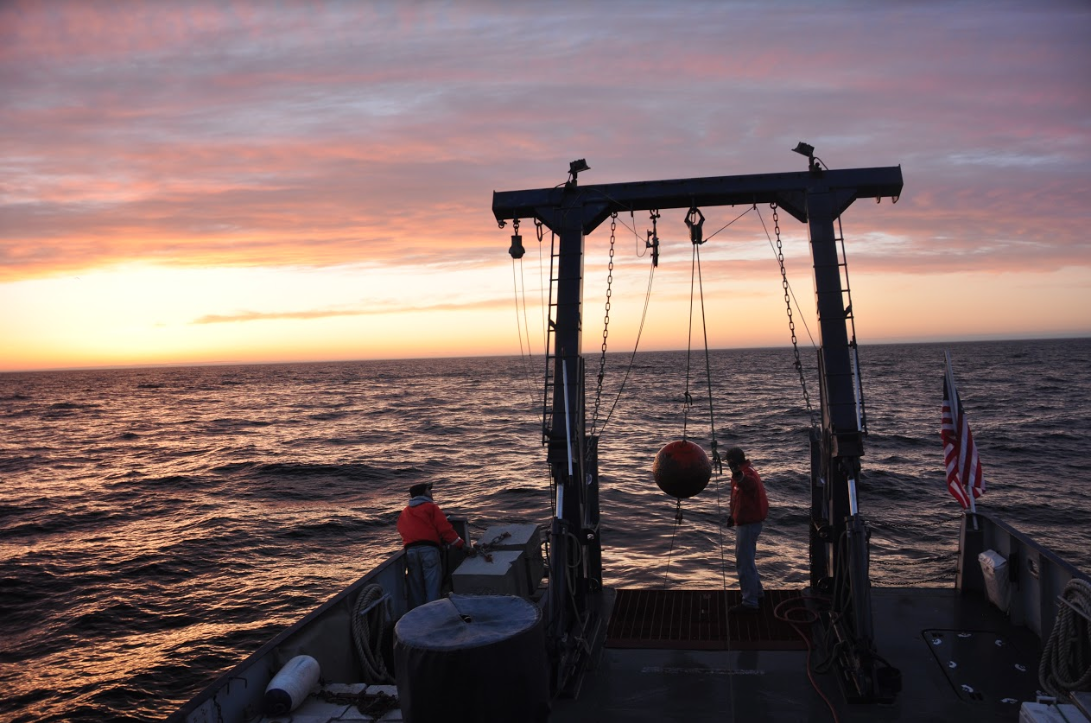
Researchers recover a mooring with their research boat, the R/V Blue Heron. Image: Daniel Titze
By Steven Maier
Researchers excited about a recently announced Great Lakes research consortium are warily eyeing proposed federal budget cuts that could threaten its effectiveness.
The University of Michigan recently announced federal support for the creation of the Cooperative Institute for Great Lakes Research. The Ann Arbor, Michigan, institution will head the partnership of nine universities, the National Oceanic and Atmospheric Administration (NOAA)-run Great Lakes Environmental Research Laboratory, advocacy groups, manufacturers and nongovernmental agencies.
The institute bolsters communication among research teams around the Great Lakes, helping them to plan collaboratively and pool resources. The good news: Operations will be funded largely through a five-year $20 million NOAA grant.
The University of Michigan will provide $2.53 million; another $2.8 million comes from partner universities. Central Michigan University, Michigan State University, the University of Minnesota Duluth, the University of Wisconsin-Milwaukee, Grand Valley State University, Cornell University, the University of Windsor and Ohio State University round out the list of academic partners.
They’re joined by advocacy groups like the Nature Conservancy and National Wildlife Federation, the Ann Arbor, Michigan-based engineering firm Limnotech and national and international agencies and programs–the International Joint Commission, Great Lakes Commission and NOAA’s Great Lakes Observing System.
“We tried to partner as broadly as possible across the Great Lakes so we could have the biggest impact possible,” said Tom Johengen, a University of Michigan research scientist and associate director of the consortium.
The new organization replaces the Cooperative Institute for Limnology and Ecosystems Research. Johengen has worked with that group since its genesis in 1989.
The new consortium’s NOAA grant will result in $4 million per year in research funding, up from the $3.4 million per year the previous organization received.
The change in name reflects the new institute’s aim for a more collaborative approach with partners, engaging in more up-front planning to meet common goals, Johengen said. The organization is also adopting a broader scope, engaging with advocacy groups, nongovernmental organizations and agencies to better connect with the public.
“It’s all about working smarter and with more impact, and engaging society and the human element,” Johengen said.
The National Wildlife Federation, one of the new partners in the institute, will contribute staff and resources to further collaborative research for the partnership, said Michael Murray, a staff scientist with the federation. It will also work to communicate implications of institute-sponsored research to the public and lawmakers. It will bring to the table existing relationships with organizations around the region, Murray said, to better collaborate with organizations doing on-the-ground conservation or advocacy work.
“We can serve as that bridge, that link to other NGOs,” Murray said. “We’re definitely excited about working with U of M and other partners on this.”
The federation has worked before with almost all of the parties involved in the new consortium, but not necessarily in an official capacity like this, he said.
Robert Sterner, director of the Large Lakes Observatory at the University of Minnesota-Duluth and a regional investigator for the new partnership, said he’s excited about its potential. The name has changed but the goal remains connecting academic research with NOAA resources, he said. Scientists need this collaboration to further their research.
“We lack the connective tissues that CIGLR could provide,” Sterner said.
Tempering the news is that the group’s ambitions may face downsizing as the White House announced its newest budget proposal for the 2018 fiscal year on May 23. Like an earlier proposal, it calls for an elimination of the $300 million-per-year Great Lakes Restoration Initiative and cuts to the Environmental Protection Agency, the U.S. Geological Survey, the Department of Energy and a 16-percent cut to NOAA.
CILER spent more than $4 million on research, as much as $3 million of which was funded through the restoration initiative, Johengen said.
“That would be hard to replace through other competitive sources of funding right now,” he said.
Others agree.
“The 800-pound gorilla, the elephant in the room, whatever you call it, is the federal budget,” said J. Val Klump, dean of the School of Freshwater Sciences at the University of Wisconsin-Milwaukee and another regional investigator with the existing Great Lakes partnership.
A cut to the restoration initiative would likely force the institute to cut programs and its 30-person staff, Johengen said. CIGLR would lose its most direct source of funding and have to compete for other grants from NOAA or other agencies.
Sterner said he’s “watching keenly” as the budget progresses. Though much has been said about the cuts to the restoration initiative, he’s more concerned about blows to other critical funding partners like NOAA and the National Science Foundation.
Bipartisan opposition to the initiative’s elimination has grown as representatives from Great Lakes states call for restored funding. Congress makes the final call on any cuts, and the budget is far from resolved.
Research in the Great Lakes is necessary due to the quickly changing nature of the local environment, Klump said, and the proposed cuts threaten that mission.
“Lake Michigan doesn’t look at all what it used to 10, 15 years ago. It’s unusual to see a system so large change so quickly,” he said.
Central Michigan University, the University of Windsor and Cornell are joining the new group as partners after operating as affiliates of the previous organization, Johengen said. That makes them eligible for programs like institute-sponsored post-doctorate and graduate student fellowships and research summits.
The process of narrowing the partner list down to the final nine universities was difficult, Johengen said. Much of that decision hinged upon considerations of the resources and infrastructure of potential partners — those with research stations and vessels had more value.
